Project Lead and Senior Editor: Prof Rosemary Cramp
Series Editor: Derek Craig
There are currently thirteen published Corpus volumes, the very latest Derbyshire and Stafforshire published in 2018 and the very first (County Durham and Northumberland) published in 1984. Each volume consists of a fully illustrated catalogue of all known sculpture in the named region (defined according to pre-1974 English county boundaries). As well as providing consistent data and an informed analysis of the sculpture itself, each volume also includes several chapters covering subjects such as the form and distribution of motifs, historical background and regional geology. Those volumes which remain in print production may be purchased from the British Academy via the Oxford University Press. The remaining volumes are now out of print, though it may be possible to obtain them through second-hand bookshops.
 This volume represents a synthesis of resent research and a complete survey of the Anglo-Saxon and Anglo-Scandinavian sculpture of the two counties of Derbyshire and Staffordshire. It shows that in the early Middle Ages Derbyshire and Staffordshire offered a vibrant milieu in which influential artistic ideas could develop and spread, not just in carved stone but also in manuscripts, metalwork and other materials, and that craftsmen, working for ecclesiastical and secular patrons, produced works of the highest quality. Introductory chapters set the material within historical, topographical, archaeological and art-historical contexts, as well as its scholarly framework, and there are specialist contributions concerning the geology of the monuments and the sculpture from the (originally) royal ecclesiastical site at Repton in Derbyshire. There is a full photographic record of each monument, and many of the images were taken especially for the volume. The monuments include important collections of material from Derby (St Alkmund's) and Repton, as well as individual sculptures of the highest quality such as the Lichfield Angel, cross-shafts from Bakewell and Bradbourne, the unique column standing at Wolverhampton and the sarcophagus cover from Wirksworth.
This volume represents a synthesis of resent research and a complete survey of the Anglo-Saxon and Anglo-Scandinavian sculpture of the two counties of Derbyshire and Staffordshire. It shows that in the early Middle Ages Derbyshire and Staffordshire offered a vibrant milieu in which influential artistic ideas could develop and spread, not just in carved stone but also in manuscripts, metalwork and other materials, and that craftsmen, working for ecclesiastical and secular patrons, produced works of the highest quality. Introductory chapters set the material within historical, topographical, archaeological and art-historical contexts, as well as its scholarly framework, and there are specialist contributions concerning the geology of the monuments and the sculpture from the (originally) royal ecclesiastical site at Repton in Derbyshire. There is a full photographic record of each monument, and many of the images were taken especially for the volume. The monuments include important collections of material from Derby (St Alkmund's) and Repton, as well as individual sculptures of the highest quality such as the Lichfield Angel, cross-shafts from Bakewell and Bradbourne, the unique column standing at Wolverhampton and the sarcophagus cover from Wirksworth.
Volumes can be purchased direct from the Oxford University Press.
 Carved and decorated stone-work is a rare survival from the period before the Norman Conquest. In Nottinghamshire it survives as large crosses and as small fragments - to be found in churches, in public spaces and in museum collections.
Carved and decorated stone-work is a rare survival from the period before the Norman Conquest. In Nottinghamshire it survives as large crosses and as small fragments - to be found in churches, in public spaces and in museum collections.
This is the first book to provide an authoritative listing, description and illustration of all examples of this type of decorated stone sculpture in Nottinghamshire. Each example is illustrated in a substantial catalogue containing high quality photographs, maps and interpretative drawings. In the introductory chapters the authors explore the geological and historical background of the sculptures and provide an overview of the types of style and ornament.
The new information revealed by the systematic study of these major survivals of Anglo-Saxon art and archaeology demonstrates the major contribution that this category of material can make to an obscure and under-investigated period in Midlands history. Nottinghamshire emerges with a distinctive identity in the pre-conquest period, having strong connections both with the Mercian state to its south and with the Northumbrians to the north.
This volume may be ordered and purchased from Oxford University Press.
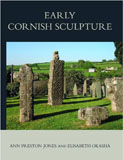 First comprehensive publication of the material for 100 years
First comprehensive publication of the material for 100 years
Each sculpture is illustrated in clear black and white photography
Additional colour plates show key sculptures in their setting
This book is part of a major series published by the British Academy. Volume 11 surveys the county of Cornwall and provides an analytical catalogue of its early sculpture, highlighting the particular distinctiveness of Cornish sculpture compared to other regions. Readers may well be astonished at the range and scale of the Cornish monuments.
Introductory chapters set the material within its topographical, historical and archaeological context, considering it especially in relation to its development as Cornwall, at one time an independent Celtic kingdom, became part of the Anglo-Saxon realm. To fully illuminate the material, the volume includes specialist contributions on the geology of the monuments, the historical background, and the sculpture which continued the tradition of monumental carving in Cornwall after the Norman Conquest.
There is a full photographic record of each monument, taken for the most part by the authors, which highlights the fact that Cornwall, unlike some regions, has many impressive and complete monuments still surviving. A large number of these were illustrated by A. G. Langdon over a century ago in his seminal Old Cornish Crosses; however the present volume includes many stones not illustrated by Langdon and offers new interpretations and detailed photographs of others. The monuments with early sculpture include substantial free-standing crosses, altar stones, and some recumbent coped stones.The dating and context of a number of potentially early fonts and some simple cross-incised stones is also discussed.
The relationship of the Cornish sculpture to monuments in Wales, Ireland and Western Britain is of particular interest given Cornwall's position as a peninsula jutting into the western seaways. In this context, the potential role of Scandinavian influence is considered against the absence of evidence for Scandinavian settlement in Cornwall.
Readership: Archaeologists and historians of Cornwall and Anglo-Saxon sculpture; bodies such as English Heritage and Cornwall Council's Historic Environment Service
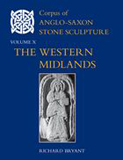 This volume surveys the western Midland counties of Gloucestershire, Herefordshire, Shropshire, Warwickshire and Worcestershire, and provides an analytical catalogue of the Anglo-Saxon stone sculptures of that region.
This volume surveys the western Midland counties of Gloucestershire, Herefordshire, Shropshire, Warwickshire and Worcestershire, and provides an analytical catalogue of the Anglo-Saxon stone sculptures of that region.
Introductory chapters set the material within an historical, topographical and art-historical context, and there are specialist contributions concerning the geology of the monuments and the analysis of surviving ninth-century paint. There is a full photographic record of each monument which includes many new illustrations.
The monuments include important collections of material from Gloucester, Deerhurst and Shrewsbury, as well as individual sculptures of the highest quality such as the Cropthorne cross-head, cross-shafts from Acton Beauchamp and Wroxeter, and the small but exquisite Lechmere Stone from Hanley Castle in Worcestershire. Some of the early monuments from the western borders of the study area are linked to the traditions of the Celtic churches of the west, but much of the material was carved at a time when Mercian art was at its zenith in the late eighth to early tenth centuries. There is also a significant body of carvings from the later tenth and eleventh centuries, but Scandinavian influence - so apparent in Northumbria and much of the rest of Mercia - is notably absent from these western counties until the early eleventh century.
This volume shows that Western Mercia offered a vibrant milieu in which influential artistic ideas could develop and spread, not just in carved stone but also in manuscripts, metalwork and other materials, and that, even in the unified Anglo-Saxon kingdom, Mercian craftsmen continued to produce works of the highest quality.
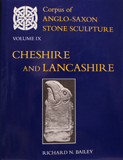 This volume provides a full analytical catalogue of all known pre-Norman sculpture from this region. As little documentary evidence survives from the area, the sculpture is vital to understanding the early development of the Church, the shifting relationships between communities, and the ways in which political affiliations gave access to a variety of cultural centers across England, Ireland, mainland Europe and Scandinavia.
This volume provides a full analytical catalogue of all known pre-Norman sculpture from this region. As little documentary evidence survives from the area, the sculpture is vital to understanding the early development of the Church, the shifting relationships between communities, and the ways in which political affiliations gave access to a variety of cultural centers across England, Ireland, mainland Europe and Scandinavia.
Among the significant carvings are the crosses at Sandbach with their elaborate figural sculpture and the delicate carvings from Halton and Hornby in the Lune valley. Much of the work is of the 10th- and 11th-century Viking period, and shows an intriguing mixture of Scandinavian-derived motifs alongside Christian iconography.
Introductory chapters set the material within its historical, topographical and art-historical context.
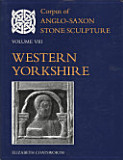 This volume completes the cataloguing of the stone sculptures of Yorkshire, and boosts our understanding of the artistic development of southern Northumbria in the pre-Viking and Anglo-Scandinavian periods.
This volume completes the cataloguing of the stone sculptures of Yorkshire, and boosts our understanding of the artistic development of southern Northumbria in the pre-Viking and Anglo-Scandinavian periods.
The monuments in the historic West Riding of Yorkshire include important collections from Dewsbury, Ilkley, Leeds and Otley, containing individual pieces of the highest quality; and there are fine examples of early architectural sculpture at Ledsham and Rothwell.
Many of the finest monuments are connected with important ecclesiastical estates, such as Ripon; the iconography of the sculptures tells us about how these estates continued into the Anglo-Scandinavian period.
Introductory chapters set the material within an historical, topographical and art-historical context, and there are specialist contributions concerning the inscriptions and geology of the monuments. There is a full photographic record of each monument which includes many new illustrations.
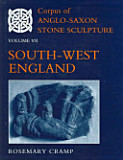 The Anglo-Saxon scupture of Wessex is less well-known as a whole that that of the other major kingdoms, but the publication of this volume (combined with Volume IV, South-East England) brings together all the monuments from the region so that the quality of West-Saxon sculpture can be appreciated fully for the first time.
The Anglo-Saxon scupture of Wessex is less well-known as a whole that that of the other major kingdoms, but the publication of this volume (combined with Volume IV, South-East England) brings together all the monuments from the region so that the quality of West-Saxon sculpture can be appreciated fully for the first time.
Volume VII surveys the historic south-western counties of Devon, Dorset, Somerset and Wiltshire, and provides an analytical catalogue of the Anglo-Saxon stone sculptures of the region. Introductory chapters set the material within a historical, topographical and art-historical context. In addition, there are specialist contributions concerning the inscriptions and geology of the monuments.
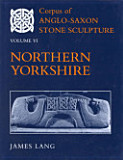 The rich and diverse visual heritage of Northern Yorkshire in the pre-Conquest period is revealed in this major addition to the much-admired Corpus series.
The rich and diverse visual heritage of Northern Yorkshire in the pre-Conquest period is revealed in this major addition to the much-admired Corpus series.
This volume surveys the sculpture in the historic North Riding of Yorkshire (excluding those parts already covered in Volume III). The total of some 400 carvings include important pre-Viking Age monuments, such as the crosses at Croft, Easby and Masham. The excavated sculpture from Whitby Abbey include a range of inscriptions which form crucial epigraphical evidence for our understanding of the pre-Conquest monastery. But Anglo-Scandinavian monuments predominate, with major collections at Brompton, Kirklevington and Lythe. A number of workshops have been identified and it was in this area that the hogback recumbent memorial first appeared.
Much of the Anglian sculpture has stylistic connections with western Yorkshire and Mercia, and the wider connections with Europe are manifest in the iconography and styles of the great crosses at Easby, Masham and Cundall/Aldborough. There are strong Irish links with the area in the Anglo-Scandinavian period.
This catalogue is a crucial piece in the Corpus jigsaw linking Volumes I, II and III, and marks the culmination of the lifetime's work of a great Anglo-Saxon scholar.
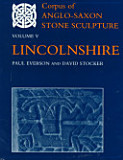 The wealth of pre-Conquest sculpture in Lincolnshire, recorded here definitively for the first time, forms a crucial source for our understanding of the Anglo-Scandinavian period in this region.
The wealth of pre-Conquest sculpture in Lincolnshire, recorded here definitively for the first time, forms a crucial source for our understanding of the Anglo-Scandinavian period in this region.
Illustrated by excellent photographs, the catalogue contains fresh discussions of such famous carvings as Crowle, Edenham, and South Kyme. It also includes many newly discovered pieces and important re-evaluations of others.
Several major groups of sculpture are identified, extending across the East Midlands in the tenth and eleventh centuries. The authors discuss how this material provides evidence for settlement and administrative structures, both lay and clerical, in this part of the Danelaw.
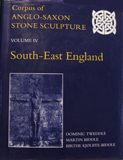 The Reculver cross from Kent and the large collection of sculpture from the important excavations at Winchester Old Minster are among many masterpieces reviewed in detail here, with many of the pieces being published for the first time.
The Reculver cross from Kent and the large collection of sculpture from the important excavations at Winchester Old Minster are among many masterpieces reviewed in detail here, with many of the pieces being published for the first time.
The significance of the material, in European terms, is that it displayed a flowering of pre-Romanesque art in the tenth and eleventh centuries, not only in the well-known Winchester Style of ornament but in architectural development.
The important increase in the scale and variety of later monuments is demonstrated here in architectural sculpture, monumental inscriptions and even the mass-produced grave covers.
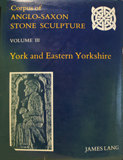 The quantity and range of carvings revealed by recent excavations at York have transformed our appreciation of the sculpture from this major medieval centre. The third volume in the series provides a comprehensive photographic record of the region's sculpture, along with a detailed description of each stone and chapters that set the historical context. Many pieces are published for the first time, including a remarkable series of slabs discovered in situ in the Minster cemetery.
The quantity and range of carvings revealed by recent excavations at York have transformed our appreciation of the sculpture from this major medieval centre. The third volume in the series provides a comprehensive photographic record of the region's sculpture, along with a detailed description of each stone and chapters that set the historical context. Many pieces are published for the first time, including a remarkable series of slabs discovered in situ in the Minster cemetery.
The carvings speak of a fusion of cultural impulses over a period when York was the political and economic focus of renewed settlement. The continuity of Anglian traditions through the period of Viking domination is clearly demonstrated. Local workshops have been identified, stylistically and by cutting techniques; even the work of individual carvers can be detected.
John Senior's geological analysis demonstrates extensive reuse of Roman building materials. Analysis of the inscriptions is provided by Raymond Page and John Higgitt.
The late James Lang held the post of Inspector of Ancient Monuments, English Heritage.
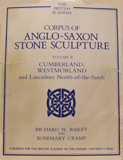 Early medieval Cumbria remains in many ways an enigma: it is rarely mentioned in documentary sources; and settlement sites of the period continue to elude the archaeologist. For the principal visible evidence of human activity in the area in the Dark Ages, one must turn to the series of stone sculptures, which have here been systematically collected and made fully accessible in print for the first time.
Early medieval Cumbria remains in many ways an enigma: it is rarely mentioned in documentary sources; and settlement sites of the period continue to elude the archaeologist. For the principal visible evidence of human activity in the area in the Dark Ages, one must turn to the series of stone sculptures, which have here been systematically collected and made fully accessible in print for the first time.
Introductory chapters relate to the earlier research on this material, the historical background to the sculpture of the Anglian and Viking periods, and the regional geology. Further chapters deal with the topography and distribution of Anglian-period sculptures, the forms and the ornament of the Anglian-period work, the Bewcastle Cross and its context, a summary for the Anglian period, the chronology of the Viking-period sculptures, their numbers, distribution, forms, and schools of sculpture (Gosforth Master, spiral-scroll school, and Beckermet group), and the late developments. The catalogue of individual pieces follows, with many plates.
 Volume I covers the pre-1974 counties of Durham and Northumberland – the heartland of the old Northumbrian kingdom of Bernicia.
Volume I covers the pre-1974 counties of Durham and Northumberland – the heartland of the old Northumbrian kingdom of Bernicia.
The sculpture reflects the changing fortunes of this area, from the monastic colonization in the late 7th century, when important centres such as Lindisfarne, Hexham, Wearmouth and Jarrow were established, through the zenith of its cultural flowering in the 8th, when Anglo-Saxon carvers produced monuments of a quality scarcely matched in Europe, to subsequent decline.
